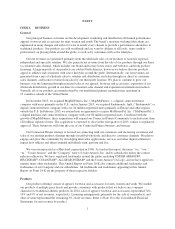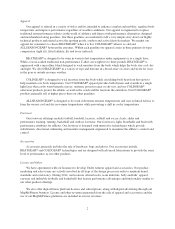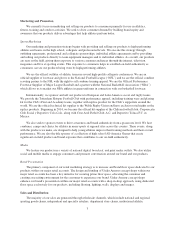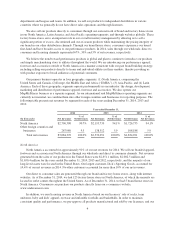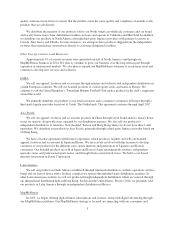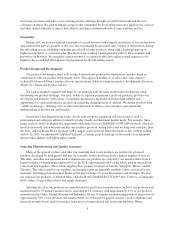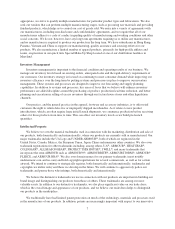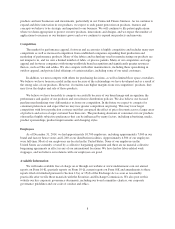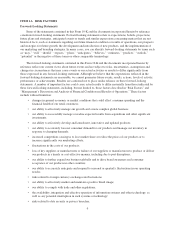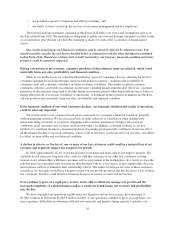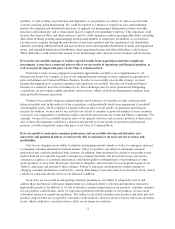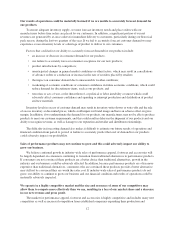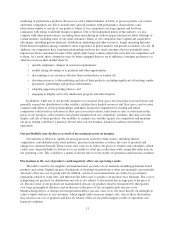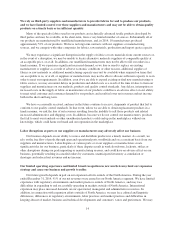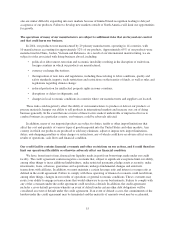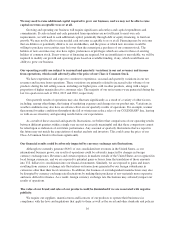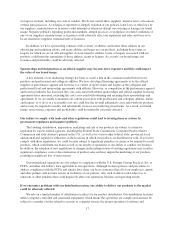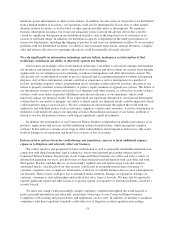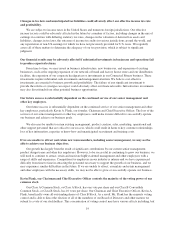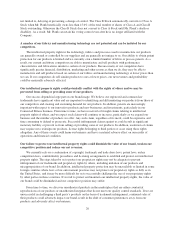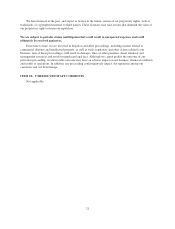Under Armour 2014 Annual Report Download - page 21
Download and view the complete annual report
Please find page 21 of the 2014 Under Armour annual report below. You can navigate through the pages in the report by either clicking on the pages listed below, or by using the keyword search tool below to find specific information within the annual report.p
roducts, as well as delays in production and shipments, as our products are subject to risks associated with
o
verseas sourcing and manufacturing. We could be required to continue to expand our sales and marketing,
p
roduct development and distribution functions, to upgrade our management information systems and othe
r
p
rocesses and technology, and to obtain more space to support our expanding workforce. This expansion could
increase the strain on these and other resources, and we could experience serious operating difficulties, including
difficulties in hiring, training and managing an increasing number of employees. In addition, as our business
becomes more complex through the introduction of more new products and the expansion of our distributio
n
channels, including additional brand and factory house stores and expanded distribution in malls and departmen
t
stores, and ex
p
anded international distribution, these o
p
erational strains and other difficulties could increase.
T
hese difficulties could result in the erosion of our brand image and a decrease in net revenues and net income.
If
we
f
a
i
l to success
f
ully manage or real
i
ze expected results
f
rom acqu
i
s
i
t
i
ons and other s
i
gn
ifi
cant
i
nvestments,
i
t may have a mater
i
al adverse e
ff
ect on our results o
f
operat
i
ons and
fi
nanc
i
al pos
i
t
i
on, as
w
ell as negatively impact the price of our Class A Common
S
tock.
F
rom t
i
me to t
i
me we may engage
i
n acqu
i
s
i
t
i
on opportun
i
t
i
es we
b
e
li
eve are comp
l
ementary to ou
r
b
us
i
ness an
db
ran
d
. For examp
l
e, as part o
f
our ongo
i
ng
b
us
i
ness strategy we
h
ave engage
di
n acqu
i
s
i
t
i
ons t
o
grow an
d
en
h
ance our Connecte
d
F
i
tness
b
us
i
ness. In or
d
er to success
f
u
ll
y execute t
hi
s strategy, we mus
t
manage t
h
e
i
ntegrat
i
on o
f
acqu
i
re
d
compan
i
es an
d
emp
l
oyees success
f
u
ll
y. Because our Connecte
d
F
i
tnes
s
b
us
i
ness
i
sare
l
at
i
ve
l
y new
li
ne o
fb
us
i
ness
f
or us, t
h
ese c
h
a
ll
enges may
b
e more pronounce
d
. Integrat
i
n
g
acqu
i
s
i
t
i
ons can a
l
so requ
i
re s
ig
n
ifi
cant e
ff
orts an
d
resources, w
hi
c
h
cou
ld di
vert mana
g
ement attent
i
on
f
rom
more pro
fi
ta
bl
e
b
us
i
ness operat
i
ons.
F
ailing to successfully integrate acquired entities and businesses or to produce results consistent wit
h
f
inancial models used in the analysis of our acquisitions could potentially result in an impairment of goodwil
l
and intangible assets, which could have a material adverse effect on our results of operations and financial
p
osition. In addition, we may not be successful in our efforts to continue to grow the number of users, maintai
n
o
r increase user engagement or ultimately realize expected revenues from our Connected Fitness community. Fo
r
example, we may not successfully increase sales of our apparel, footwear and accessory products to these users.
Any of these developments could have a material adverse effect on our results of operations and financia
l
p
osition, as well as negatively impact the price of our Class A Common Stock
.
I
f we are unable to anticipate consumer preferences and successfully develop and introduce new,
innovative and updated products, we may not be able to maintain or increase our net revenues and
profitability
.
Our success
d
epen
d
s on our a
bili
t
y
to
id
ent
ify
an
d
or
igi
nate pro
d
uct tren
d
saswe
ll
as to ant
i
c
i
pate an
d
react
to c
h
an
gi
n
g
consumer
d
eman
d
s
i
nat
i
me
ly
manner. A
ll
o
f
our pro
d
ucts are su
bj
ect to c
h
an
gi
n
g
consumer
p
re
f
erences t
h
at cannot
b
e pre
di
cte
d
w
i
t
h
certa
i
nt
y
.Ina
ddi
t
i
on,
l
on
gl
ea
d
t
i
mes
f
or certa
i
no
f
our pro
d
ucts ma
y
ma
k
e
i
t
h
ar
df
or us to qu
i
c
kly
respon
d
to c
h
an
g
es
i
n consumer
d
eman
d
s. Our new pro
d
ucts ma
y
not rece
i
ve
consumer acceptance as consumer pre
f
erences cou
ld
s
hif
t rap
idly
to
diff
erent t
y
pes o
f
per
f
ormance or ot
h
e
r
sports pro
d
ucts or awa
yf
rom t
h
ese t
y
pes o
f
pro
d
ucts a
l
to
g
et
h
er, an
d
our
f
uture success
d
epen
d
s
i
n part on our
a
bili
t
y
to ant
i
c
i
pate an
d
respon
d
to t
h
ese c
h
an
g
es. Fa
il
ure to ant
i
c
i
pate an
d
respon
di
nat
i
me
ly
manner to
c
h
an
gi
n
g
consumer pre
f
erences cou
ld l
ea
d
to, amon
g
ot
h
er t
hi
n
g
s,
l
ower sa
l
es an
d
excess
i
nventor
yl
eve
l
s, w
hi
c
h
cou
ld h
a
v
e a mater
i
a
l
a
dv
erse e
ff
ect on our
fi
nanc
i
a
l
con
di
t
i
on.
E
ven if we are successful in anticipating consumer preferences, our ability to adequately react to an
d
address those preferences will in part depend upon our continued ability to develop and introduce innovative
,
high-quality products. In addition, if we fail to introduce technical innovation in our products, consumer deman
d
f
or our products could decline, and if we experience problems with the quality of our products, we may incu
r
substantial expense to remedy the problems. The failure to effectively introduce new products and enter into new
p
roduct categories that are accepted by consumers could result in a decrease in net revenues and excess inventory
levels
,
which could have a material adverse effect on our financial condition
.
11


